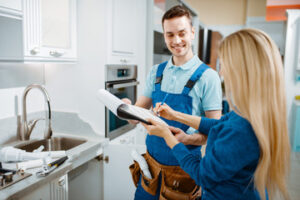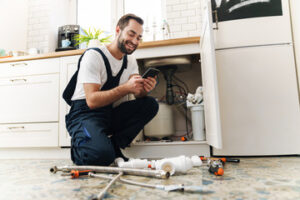Plumbing is the system of pipes and fixtures that deliver a safe supply of water and remove waste in residential and commercial buildings. Its components include hot and cold water supply lines, drain pipes, sewer pipes, venting systems, and fixtures like sinks, bathtubs, and toilets.

Plumbers must comply with federal, state, and local regulations regarding water quality, waste disposal, and safety. These standards help protect public health and the environment. Contact Plumbing Express, Inc. for professional help.
The water supply is the infrastructure for the collection, transmission, treatment and storage of drinking water. It also provides water for municipal, commercial, industrial and fire fighting purposes. The water is supplied from either surface or groundwater sources and is transported to the distribution network via supply conduits. The water is then distributed at a constant pressure to consumers’ homes, offices, and other public buildings.
In most modern societies, the water supply is provided by a public utility company that collects and distributes municipal water through a network of pipes. It usually charges a fee for the use of its services (or tariffs), and its revenues are used to cover operating costs, capital expenses, and maintenance costs.
Most public water systems draw their raw water from surface sources such as lakes, rivers or streams. However, a number of urban communities are served by underground water systems. These are based on the tapping of local aquifers by means of drilling or pumping.
Depending on the source of the water, it may be treated before entering the supply system. Treatment can involve chemical and biological transformations or physical separation of water from contaminants. It is important to protect the quality of the water supply, because it serves people for many different uses, from drinking to washing and cooking, and even for fire fighting and street flushing.
After treatment, the water is conveyed to the distribution system through a network of pipes. This network can be based on gravity or on the application of positive pressure. The latter is normally achieved by storing the water in reservoirs or cisterns situated at elevated locations and, for large networks, through the use of pumps.
The design of the supply network depends on a number of factors, including current and future demand, leakage, pipe size, hydraulic constraints such as required pressures or maximum flow rates, and other considerations such as cost and safety. The capacity of the system is often optimized by applying a least cost model that takes into account factors such as pipe sizes and hydraulic constraints.
Drainage
Drainage is a part of plumbing that removes wastewater from homes and businesses. It prevents flooding, structural damage and rotting/mildew by transporting waste water to sewage systems or septic tanks. It also helps protect the environment by reducing the amount of contaminants that enter rivers and oceans.
Unlike supply pipes, drainage pipes are not under any pressure. They rely on gravity to move waste water away from fixtures such as sinks, tubs and toilets. This system also does not use any chemicals or bactericides to dispose of the waste, which makes it more environmentally friendly.
The drainage system is made up of pipes that connect all the water outlets in a house to one main drain. These drains can be open or buried. Open drains are often used in garden areas to collect excess rainwater, while buried pipes are more common in residential and commercial buildings. They can be made of concrete, clay or plastic. They may be pre-formed or made on site, and the pipe material should be appropriate for the climate and soil conditions.
In general, drain pipes should be wide enough to allow water to flow through freely. They should also be well-sloped to direct wastewater to the sewage system. The traps (S-traps for toilets, P-traps for sinks) should be correctly installed to keep out debris and odors. These traps should be checked regularly for wear and tear, and replaced if needed.
When a drain becomes blocked, it can be very difficult to clear the blockage. It is often best to call a professional plumber. Drainage systems are often complex and can be dangerous to work on without the proper training and tools.
A plumbing specialist can clear even the most stubborn drain blockages without damaging the pipes or leaving any residue behind. A thorough inspection will reveal any potential issues before they become a problem, and regular maintenance can avoid costly repairs in the future. The drainage system is a vital part of any home or business, so it’s important to understand how it works and the problems it can cause.
Sewage Removal
Sewage, sometimes called wastewater, contains the waste products of people living in homes and businesses. It flows into sewer lines and septic systems or, in the case of a municipal system, into sewage treatment plants. The sewage undergoes primary, secondary and tertiary treatments in order to be cleaned and safely returned to natural bodies of water.
Sewage first enters the treatment plant through screens to catch trash and debris, such as wood pieces, plastics, rags, paper and bottles. It then goes to the grit removal stage, where inorganic solids like sand, grit and cinders are removed from the wastewater. This prevents these materials from clogging pumps and valves inside the facility. The screened wastewater then goes to the clarifier tank for primary treatment. This tank sits for a few hours so the solids can settle to the bottom of the tank and the grease can float to the top. It’s then skimmed off with scrapers and is separated from the sewage. The sewage then goes to another tank for aeration, where air and new sewage are mixed in order to help the bacteria decompose the sewage faster. The aeration tank is also where the chemical oxygen demand (COD) of the sewage is reduced by adding chlorine.
Secondary treatment takes place in a lagoon. This is where the sewage sits in a large, human-made pond that allows indigenous plants to colonize it. The plants and bacteria absorb the organic carbon in the sewage, which helps break it down. This process also reduces nitrogen, which is accomplished by introducing nitrifying bacteria to the system.
The sludge that’s left behind after the primary and secondary treatments is called sludge digestion or digested sludge. This process can produce methane biogas, which can be used to generate electricity. It can also be incinerated, condensed and heated to disinfect it before being reused as a fertilizer.
Some sewage is treated on-site using a septic tank and drainage field or by “lagooning.” This involves storing the sewage in a lagoon of standing water where it’s subjected to natural treatment from wind, sun and rain.
Installation
Plumbing is the system of pipes and fixtures that supply potable water and remove waste in a building. Its elements include the main line that connects to a municipal water supply or private well, a network of branch lines that feed individual fixtures, and drainage pipes that transport wastewater to sewer systems or septic tanks.
Plumbers install these components, ensuring they’re properly fitted and sealed to prevent leaks. They also consider factors like pipe material and water temperature when selecting products, as these can affect how efficiently a fixture runs, how long it lasts, and its power consumption. They’re also responsible for connecting appliances like washing machines, dishwashers, and ice makers, ensuring they’re safe to operate and that they use the proper water pressure and temperature.
In new construction, a plumber begins by laying out the main water line system. They dig trenches to route the lines underground, avoiding sensitive soil conditions. Then they install plumbing fixtures and appliances, such as toilets, sinks, faucets, and water heaters. They consider a building’s layout and design to choose fixtures that will work best in each space. They’re also aware of a structure’s aesthetic, ensuring that all pipes and fixtures match seamlessly.
After installing the primary pipes and fixtures, plumbers test their work to ensure all connections are secure and that water flows as expected. They also look for any potential issues with appliances and make corrections before finishing the project. This quality control phase is crucial to preventing future problems with water supply, draining, or sanitation.
Aspiring plumbers must have a strong understanding of local plumbing codes and regulations to ensure their work meets strict standards. The International Plumbing Code (IPC) sets forth universal standards for plumbing design, installation, and maintenance to protect public health and safety. Plumbers must also stay up-to-date on the latest codes to maintain their licenses and remain relevant in the industry. They must also understand the unique challenges of working on commercial and residential plumbing projects, including varying demands and infrastructure requirements.

